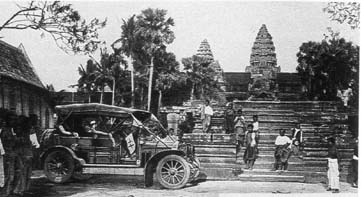Die Geschichte Kambodschas

The early history of the Khmer is known as the pre-Angkor period. It begins with the second century AD, and the foundation of the kingdom of Funan. The religious center was established in the southern part of the Mekong (today´┐Żs Vietnam) ad Oc Eo, a city on the Golf of Thailand. The Funan was well known by the Chinese, Indian and throughout South-East Asia as a trading center. The contact with the Indians, brought elements of their culture and religion to the kingdom of Funan.
In the mid 6th century a vassal state of the Funan in the northern part of today´┐Żs Cambodia, called by the Chinese as ´┐ŻChenla´┐Ż, took over the kingdom of Funan. From the mid 6th to the 9th century, there was a lot of turmoil in the region.
In 790 AD, king Jayavarman II came back from Java, where he was detained for several years. It was this king founding the Khmer empire, reunifying the Khmers and freeing them from the Javanese vassalage. This liberation was celebrated in 802 AD on Phnom Kulen, a hill north of the lake Tonle Sap. For the next six hundred years the kingdom of Cambodia flourished.
In 1431 (post-Angkor period), the king of Cambodia left the Royal City and the court moved south, beyond the Great Lake, after the Siam (today Thailand) captured Angkor. Most of the sources refers that the capital was moved to Srei Santhor. Until the 17th century the king and his court settled at other sites, such as Udong and Lovek.
During this period, Angkor was never left by the Khmers. There where monks on the site of Angkor Wat, taking care of the temples. And the temples was not first discovered by the French, as mentioned many times. Before the French came to Angkor, a few traders, adventurers stopped of there from the middle of the 16th century. The temples was visited by Portuguese´┐Żs, such as the chronicler Diogo do Couto, Spanish´┐Żs and Japanese pilgrim, he drawn the first map of Angkor Wat (around 1630).
In 1794 Thailand annexed the provinces Battambang and Angkor. After the Thais opened its doors to Europe, many Western floated to Thailand. Henry Mouhot arrived in Bangkok in September 1858, which was the starting point to visit Angkor. Although the temples of Angkor where mentioned by his predecessor, as strange and grandiose sights, there where no illustration of the temples. Henry Mouhot was filling this gap. For this reason he became famous, but after his death. Mouhot died of exhausting on 10 November 1860 near Luang Prabang, Laos. His description of Angkor where published in English the first time in 1864 with a foreword by his brother. He referred to the ´┐Żvast ruins which he discovered in Cambodia´┐Ż. This is perhaps the reason, why the fact, that Mouhot had ´┐Żdiscovered´┐Ż Angkor, was mainly accepted.
In 1863, before Mouhot´┐Żs description was published, the French Vice-Admiral Bonard visited Cambodia for the first time. His goal was to reach agreement with the Cambodian king, to turning Cambodia and Angkor, in a French protectorate. This agreement was signed in 1864.
In 1907 finally Angkor and Battambang was returned to Cambodia by Thailand. The Cambodians had not forgotten about their past. And so it was a great celebration at Angkor Wat joined by King Sisowat and many French residents.
At the same time the tourist´┐Żs arrived in Angkor. In three months, more then two hundred tourist visited Angkor. And a visit at this time was not simple as today. To reach the temples, the tourist had to go by boat and buffalo-drawn cart. On site a straw hut on piles served as a hotel. Guests had to bring their own cooking equipment, food and bed linen.
The French established the ´┐ŻEcole Francaise d´┐ŻExtreme-Orient, which´┐Żs target was to clear the temples from the vegetation, restruction and study the temples and ensure the conservation.. One idea was also to improve the access for visitors. That means to build roads to and around the temples. Jean Commaille cleared Angkor Wat and Angkor Thom from the vegetation. But the cleaning is never finished as after each rain season the vegetation is growing back.
In 1925, Angkor was officially opened as a park. At this time the routs around the temples has been finished. Still today the roads are called ´┐Żshort circuit´┐Ż and ´┐Żlong circuit´┐Ż. After the opening, the tourism was booming. They came in convoys by car from Saigon (today Ho Chi Minh) and Bangkok.
In 1949 Cambodia got his own government and in 1953 finally their first independents since 1864. In the `50s and `60s, Cambodia was a prospered country and Phnom Penh was called ´┐ŻParis in Indochina´┐Ż.
From 1969, Cambodia suffered more and more be the bombings from U.S Army. They wanted to destroy the Vietnamese hiding in Cambodia along the Vietnamese border. In 1970 General Lon Nol overthrew Prince Sihanouk ho was visiting Peking. On 17 April 1975, the Khmer Rouge pushed out Lon Nol and ruled Cambodia. More then one million Khmers died under the reign of Pol Pot. King Sihanouk was brought to a deserted capital and maintained under house arrest.
I1979, the Vietnamese, backed by the army of the People´┐Żs Republic of Kampuchea, pushed the Khmer Rouge back in to the forest and a long guerrilla war began. The Paris Peace Agreement was reached in 1991, which has been created by the United Nations. 22'000 UN troops ensured in 1993 the first free election in Cambodia. King Norodom Sihanouk became King of Cambodia for the second time.
Touren - Hotels - ´┐Żber Kambodscha - Reiseziele - Reise Information - Online Buchen - Info eMail - ´┐Żber Uns - Lolei Travel
|
|
